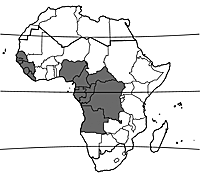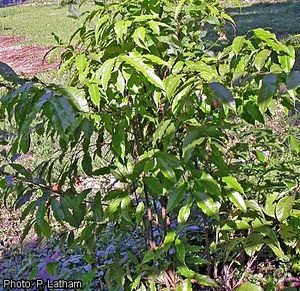Carpolobia alba (PROTA)
Introduction |
| General importance | |
| Geographic coverage Africa | |
| Geographic coverage World | |
| Fruit | |
| Vegetable | |
| Medicinal | |
| Timber | |
| Fuel | |
| Ornamental | |
| Food security | |
Carpolobia alba G.Don
- Protologue: Gen. hist. 1: 370 (1831).
- Family: Polygalaceae
- Chromosome number: 2n = 22
Synonyms
- Carpolobia glabrescens Hutch. & Dalziel (1927).
Vernacular names
- Poor man’s candle (En).
Origin and geographic distribution
Carpolobia alba occurs from Senegal to Liberia and from eastern Nigeria to the Central African Republic, DR Congo and northern Angola.
Uses
The wood is used for making house posts, walking-sticks, cudgels, tool handles, spoons, combs, toys, games and traps. Because of its flexibility and resonance, it is used for musical instruments and cattle-sticks. It is useful for carving and turnery. The stems are used as torches as they burn even when fresh. Twigs are used as chew-sticks.
In southern Nigeria bark decoctions are used internally and externally to treat rheumatism. A maceration of the leaves and twigs is taken against stomach complaints. Leaf sap is dropped into the eye against cataract. The root is considered invigorating, aphrodisiac and vermifuge; it may be chewed or taken in decoction and is also taken in combinations with other medicines. Together with the fruit it enters in medicines to increase vitality. Mixed with other plants, the roots are used against miscarriage and poisoning, and to protect against spirits and spells. The sweet pulp of the fruit is eaten, while the fruit is also eaten green.
Production and international trade
The wood of Carpolobia alba is only used and traded locally.
Properties
The heartwood is yellowish brown and rather indistinctly demarcated from the sapwood. The wood has a fine and even texture. It is hard and takes a fine polish. It is resistant to termites. The wood is oily to the touch and burns even when wet.
The roots contain complex triterpene glycosides, which possibly have antiplasmodial properties.
Description
- Shrub or small tree up to 5 m tall; bark surface smooth; twigs short-hairy, soon becoming glabrous.
- Leaves alternate, simple and entire; stipules absent or reduced to glandular spots; petiole 1.5–3 mm long; blade elliptical, 1.5–12.5(–15) cm × 1–5(–6.5) cm, base rounded or cuneate, apex usually acuminate, papery, short-hairy below or nearly glabrous, pinnately veined with (3–)4–7(–9) pairs of lateral veins.
- Inflorescence an axillary raceme up to 3 cm long, short-hairy, (1–)2–5(–7)-flowered.
- Flowers bisexual, zygomorphic, 5-merous; pedicel 3–7 mm long; sepals unequal, ovate to elliptical, 3–8 mm × 2–6 mm, margins hairy; petals unequal, 1–2 cm long, 2 upper ones oblong, 2 lateral ones narrowly obovate and lower one hooded, white, cream or yellowish, purplish red to bright pink on tips; stamens 1–1.5 cm long, fused for more than half their length into a sheath fused again to upper petals; ovary superior, ellipsoid, slightly 3-lobed, tapering into curved style c. 1 cm long.
- Fruit a globose to obovoid berry up to 2.5 cm × 2 cm, slightly 3-lobed, glabrous, yellow to orange when ripe, pointed, 1–3-seeded.
- Seeds ellipsoid to ovoid, flattened, 0.5–1 cm long, densely rusty-brown hairy.
Other botanical information
Carpolobia comprises 5 species, all in mainland tropical Africa but one also in Madagascar.
Carpolobia lutea
Carpolobia lutea G.Don is a shrub or small tree up to 5 m tall, occurring in the forest understory from Guinea to Nigeria. It is used for similar purposes as Carpolobia alba, with which it has been much confused. In addition, its root is used against pain and to ease childbirth.
Carpolobia goetzei
Carpolobia goetzei Gürke, called ‘mtindapo’ in Swahili, is a shrub or small tree up to 5 m tall, occurring in rather dry forest and savanna woodland from eastern DR Congo and southern Sudan to Mozambique and northern Madagascar. Its wood is probably used for similar purposes as that of Carpolobia alba, and in East Africa its roots are used for similar medicinal purposes. In Mozambique the wood is used as firewood. Its fruits are eaten.
Ecology
Carpolobia alba occurs in the understory of evergreen forest, semi-deciduous forest and gallery forest, up to 400 m altitude.
Genetic resources
Carpolobia alba is widespread and locally common; there are no indications that it is in danger of genetic erosion.
Prospects
The wood is likely to remain locally of some importance for carving and implements where hardness and a smooth surface are valued, as well as for house posts where durability is important. Its wood properties and pharmacological properties deserve research attention.
Major references
- Aké Assi, L., Abeye, J., Guinko, S., Riguet, R. & Bangavou, X., 1985. Médecine traditionnelle et pharmacopée - Contribution aux études ethnobotaniques et floristiques en République Centrafricaine. Agence de Coopération Culturelle et Technique, Paris, France. 140 pp.
- Breteler, F.J. & Smissaert-Houwing, A.A.S., 1977. Revision of Atroxima Stapf and Carpolobia G. Don (Polygalaceae). Mededelingen Landbouwhogeschool Wageningen 77–18. Veenman, Wageningen, Netherlands. 45 pp.
- Burkill, H.M., 1997. The useful plants of West Tropical Africa. 2nd Edition. Volume 4, Families M–R. Royal Botanic Gardens, Kew, Richmond, United Kingdom. 969 pp.
- Neuwinger, H.D., 2000. African traditional medicine: a dictionary of plant use and applications. Medpharm Scientific, Stuttgart, Germany. 589 pp.
- Normand, D., 1955. Atlas des bois de la Côte d’Ivoire. Tome 2. Centre Technique Forestier Tropical, Nogent-sur-Marne, France. 132 pp.
Other references
- Afolayan, A.J. & Yakubu, M.T., 2009. Erectile dysfunction management options in Nigeria. Journal of Sexual Medicine 6(4): 1090–1102.
- Aubréville, A., 1959. La flore forestière de la Côte d’Ivoire. Deuxième édition révisée. Tome deuxième. Publication No 15. Centre Technique Forestier Tropical, Nogent-sur-Marne, France. 341 pp.
- Breteler, F.J., 2010. Novitates gabonenses 74. A new species of Carpolobia (Polygalaceae) from Gabon and adjacent Congo. Edinburgh Journal of Botany 67(2): 343–346.
- Chhabra, S.C., Mahunnah, R.L.A. & Mshiu, E.N., 1991. Plants used in traditional medicine in eastern Tanzania. 5. Angiosperms (Passifloraceae to Sapindaceae). Journal of Ethnopharmacology 33: 143–157.
- Coates Palgrave, K., 2002. Trees of southern Africa. 3rd Edition. Struik Publishers, Cape Town, South Africa. 1212 pp.
- Gassita, J.N., Nze Ekekang, L., De Vecchy, H., Louis, A.M., Koudogbo, B. & Ekomié, R. (Editors), 1982. Les plantes médicinales du Gabon. CENAREST, IPHAMETRA, mission ethnobotanique de l’ACCT au Gabon, 10–31 juillet 1982. 26 pp.
- Mitaine-Offer, A.-C., Miyamoto, T., Khan, I.A., Delaude, C. & Lacaille-Dubois, M.-A., 2002. Three new triterpene saponins from two species of Carpolobia. Journal of Natural Products 65(4): 553–557.
- Mitaine-Offer, A.-C., Miyamoto, T., Jolly, C., Delaude, C. & Lacaille-Dubois, M.-A., 2005. Triterpene saponins from four species of the Polygalaceae family. Helvetica Chimica Acta 88(11): 2986–2995.
- Ogunsile, B.O. & Quintana, G.C., 2010. Modeling of soda-ethanol pulps from Carpolobia lutea. Bioresources 5(4): 2417–2430.
- Paiva, J., 2007. Polygalaceae. In: Beentje, H.J. & Ghazanfar, S.A. (Editors). Flora of Tropical East Africa. Royal Botanic Gardens, Kew, Richmond, United Kingdom. 61 pp.
Author(s)
- L.P.A. Oyen, PROTA Network Office Europe, Wageningen University, P.O. Box 341, 6700 AH Wageningen, Netherlands
Correct citation of this article
Oyen, L.P.A., 2012. Carpolobia alba G.Don. [Internet] Record from PROTA4U. Lemmens, R.H.M.J., Louppe, D. & Oteng-Amoako, A.A. (Editors). PROTA (Plant Resources of Tropical Africa / Ressources végétales de l’Afrique tropicale), Wageningen, Netherlands. <http://www.prota4u.org/search.asp>.
Accessed 31 March 2025.
- See the Prota4U database.


